KINS 3545 Exam #2
1/144
There's no tags or description
Looks like no tags are added yet.
Name | Mastery | Learn | Test | Matching | Spaced |
|---|
No study sessions yet.
145 Terms
Table 15.1 - identifying training status
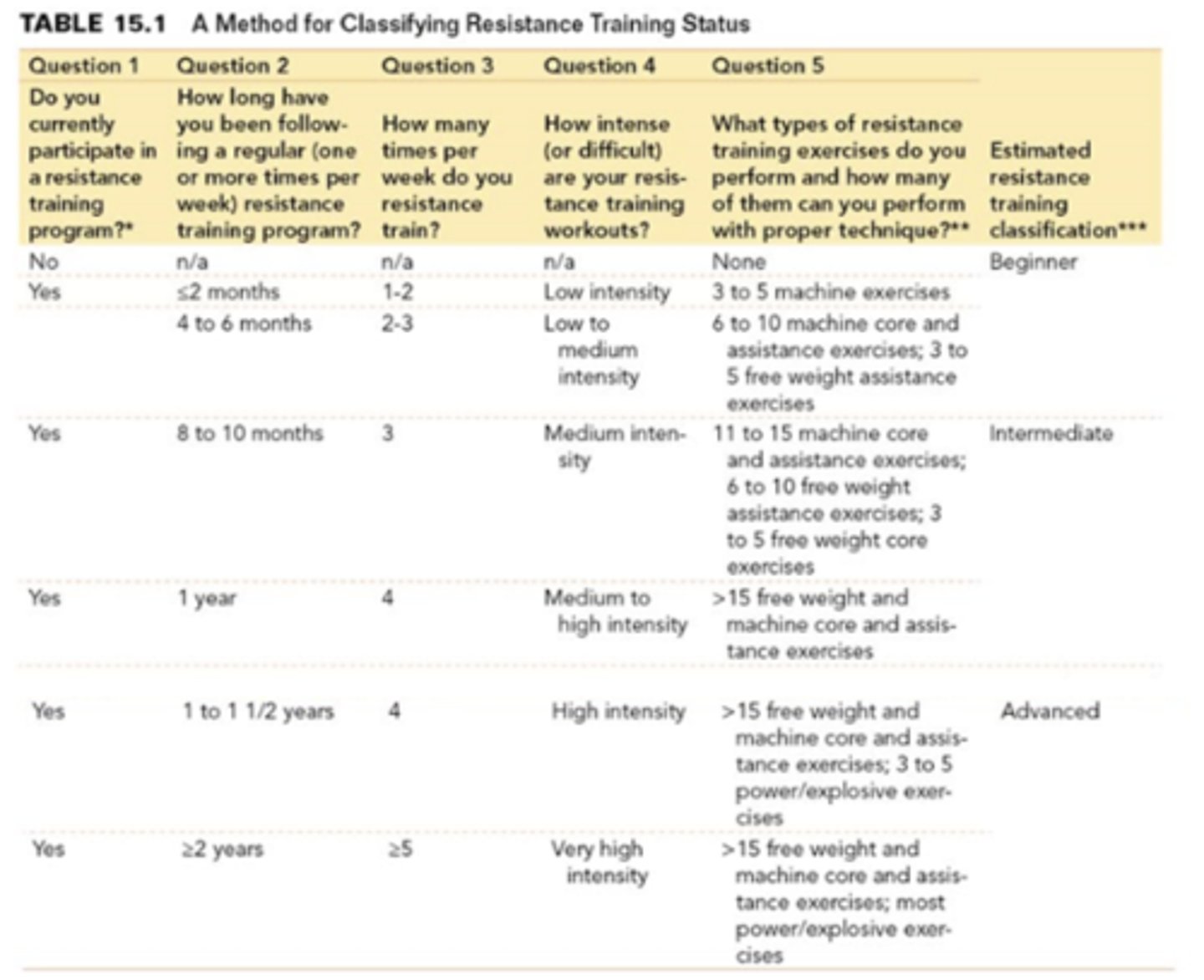
Table 15.1 Beginner?
- Don't have exercise training program
- have exercise training program of < 2 months low intensity, 1-2 x per week
- 4-6 months, low to medium, 2-3 days per week
ANYTHING WITH LOW INTENSITY
ANYTHING < 6 MONTHS
Table 15.1 - Intermediate
- 8-10 months, 3 days, medium intensity, 11-15 exercises
- 1 year, 4 days, medium to high intensity, >15 exercises
*3-4 DAYS OF EXERCISE
Table 15.1 Advanced
- 1-2 years, 4 days, high intensity, >15 exercises
- >2 years, >5 days, very high intensity, >15 exercises
Table 15.1 --> people are classified when they match_____ of the _____ criteria in a single category
3 out of 5
Table 15.2 - General Guidelines for Resistance Training Frequency
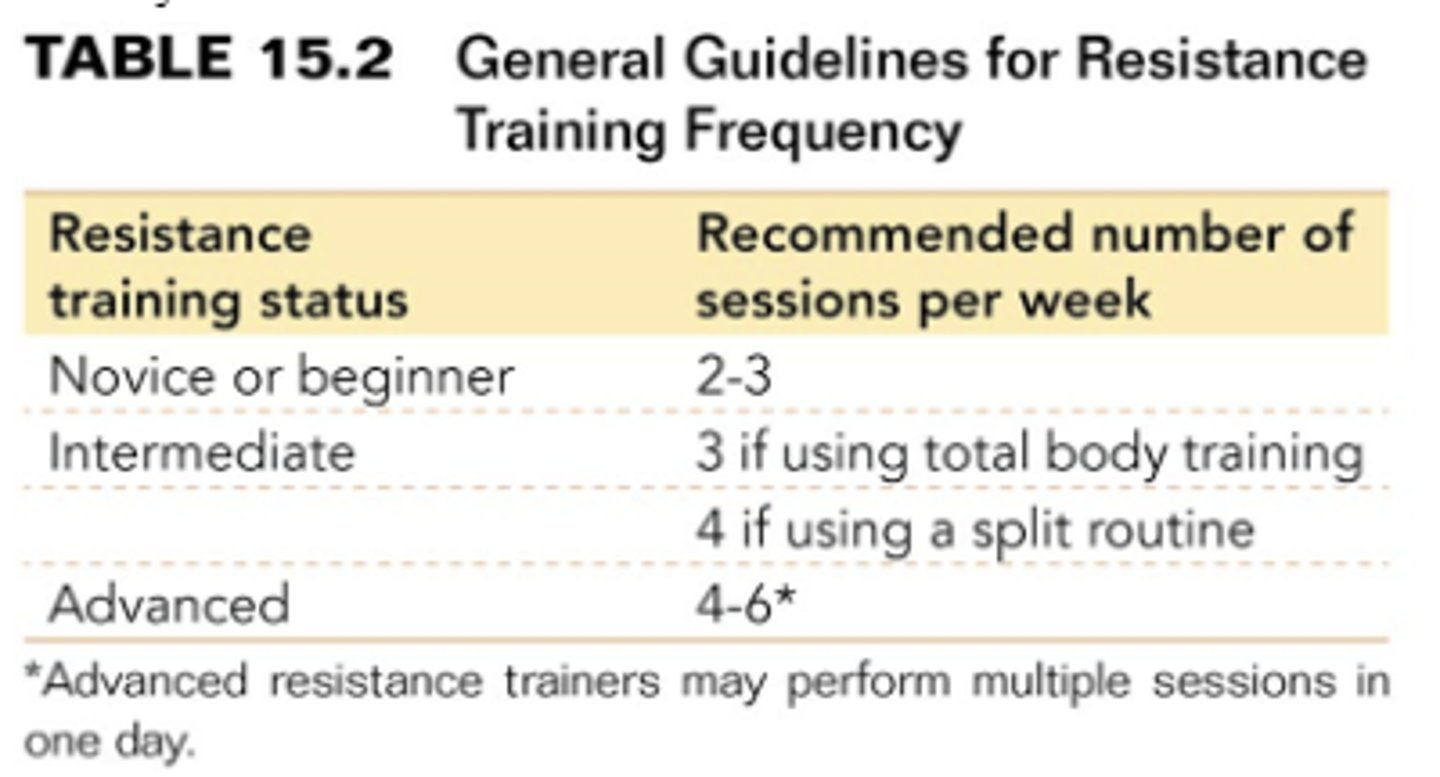
How many sessions are recommended for novice/beginner athletes?
2-3
How many sessions are recommended for intermediate athletes?
3 if total body
4 if split
How many sessions are recommended for advanced athletes?
4-6 (can do multiple in one day)
Table 15.6 - Training Load and Repetition Schemes for Targeted Goals
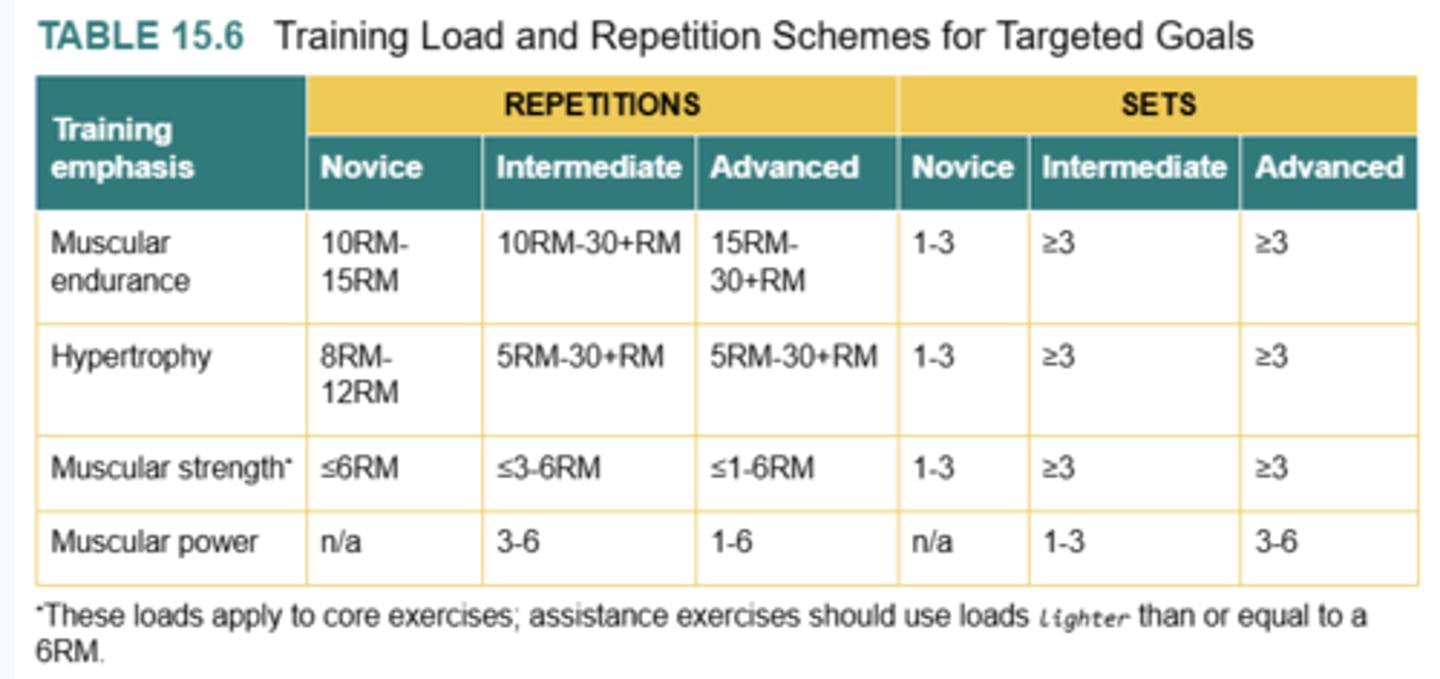
Table 15.6 - Muscular endurance
Novice - 10-15 RM, 1-3 sets
Intermediate - 10-30+ RM, >3 sets
Advanced - 15-30+RM, >3 sets
Table 15.6 - Hypertrophy
Novice - 8-12 RM, 1-3 sets
Intermediate - 5-30+ RM, >3 sets
Advanced - 5-30+RM, >3 sets
Table 15.6 - Muscular Strength
Novice - <6 RM, 1-3 sets
Intermediate - <3-6 RM, >3 sets
Advanced - <1-6 RM, >3 sets
15.6 - Muscular Power
Novice - n/a
Intermediate - 3-6 RM, 1-3 sets
Advanced - 1-6 RM, 3-6 sets
15.6 - These loads apply to _____ exercises, ________ exercises should use lighter loads
core, assistance
Table 15.9 - Rest Interval Recommendation Based on Training Goals
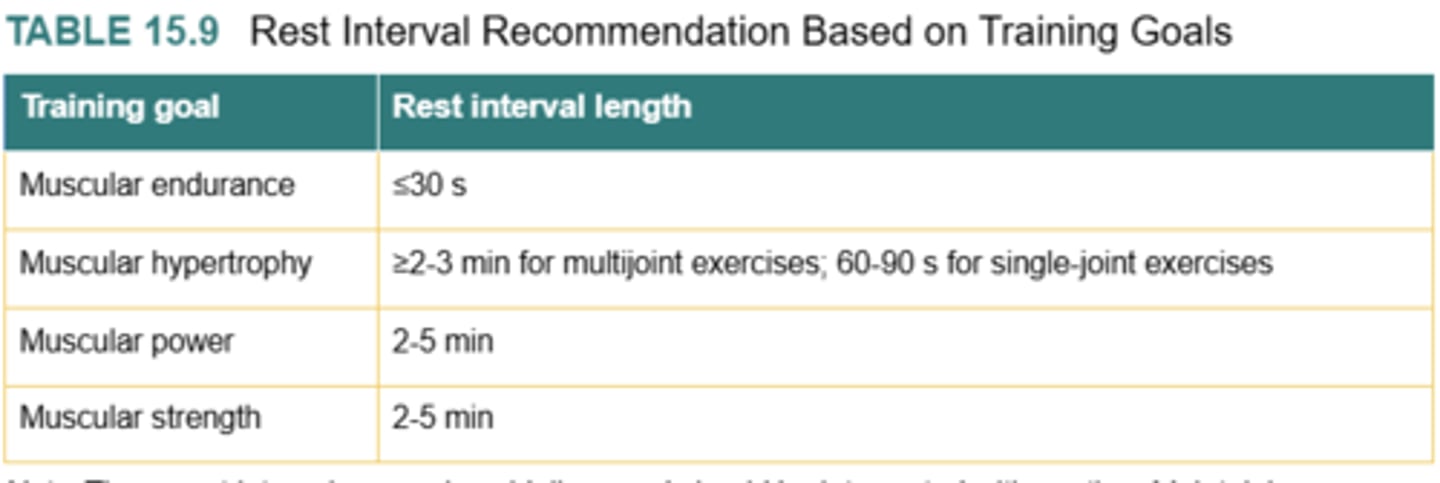
Table 15.9 - Rest for muscular endurance?
< 30 s
Table 15.9 - Rest for hypertrophy?
> 2-3 min multijoint; 60-90 sec single joint
Table 15.9 - Rest for power?
2-5 min
Table 15.9 - Rest for muscular strength?
2-5 min
Table 15.12 - Training Factor Sequencing Guidelines
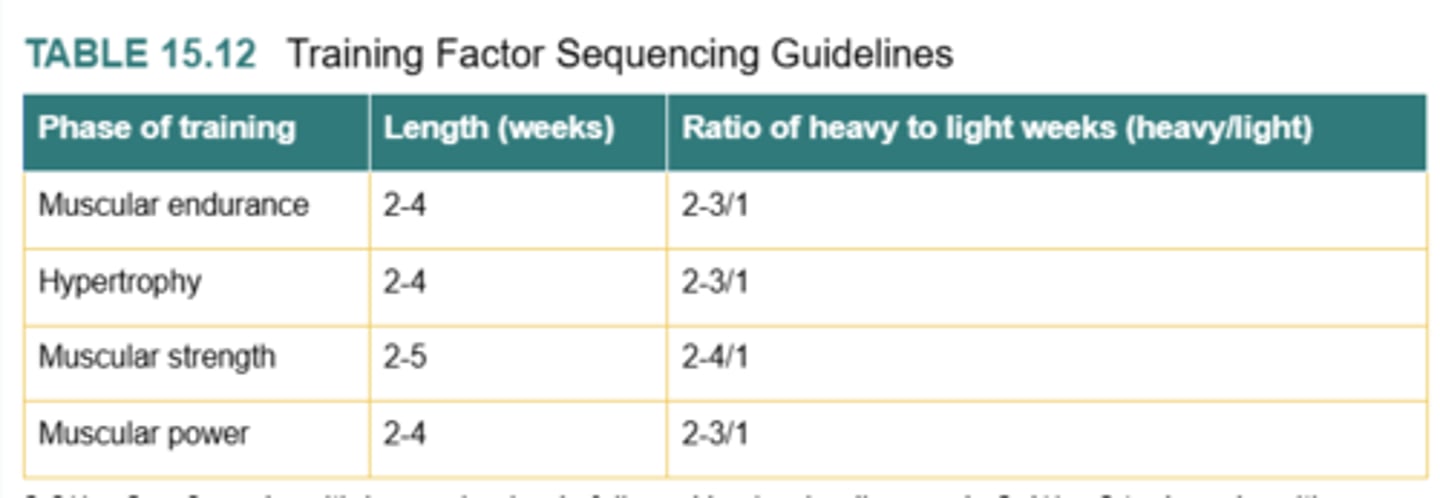
Table 15.12 - Heavy to light ratio - Muscular endurance, hypertrophy, muscular power?
length - 2-4 weeks
ratio of heavy to light weeks - 2-3/1
Table 15.12 - heavy - light ratio -Muscular strength?
length - 2-5 weeks
ratio of heavy to light weeks - 2-4/1
Figure 1 - OMNI - Resistance Exercise Scale
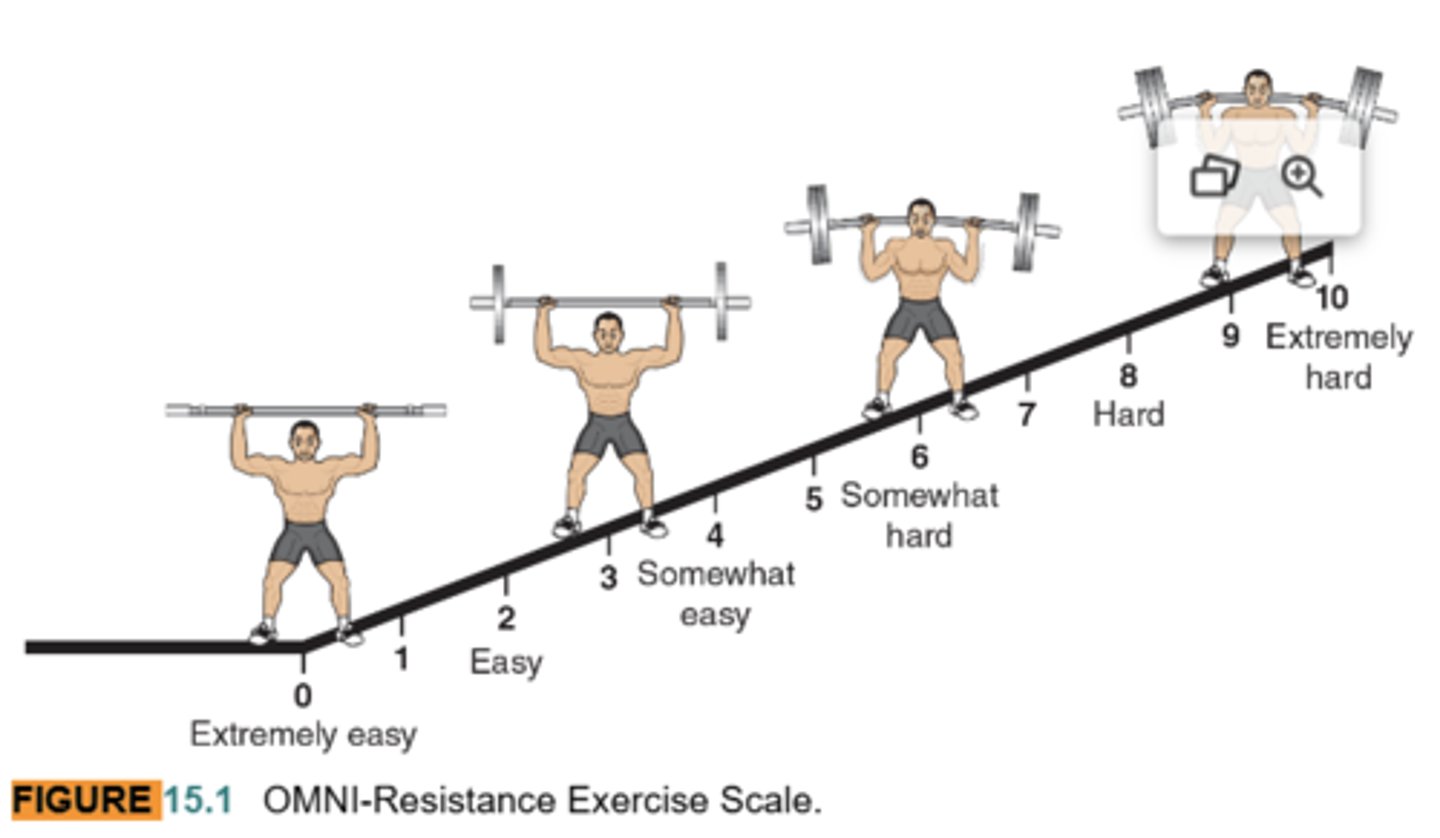
OMNI Scale
0 - extremely easy
2 - easy
4 - somewhat easy
6 - somewhat hard
8 - hard
10 - extremely hard
Figure 9.1 - RT stress continuum
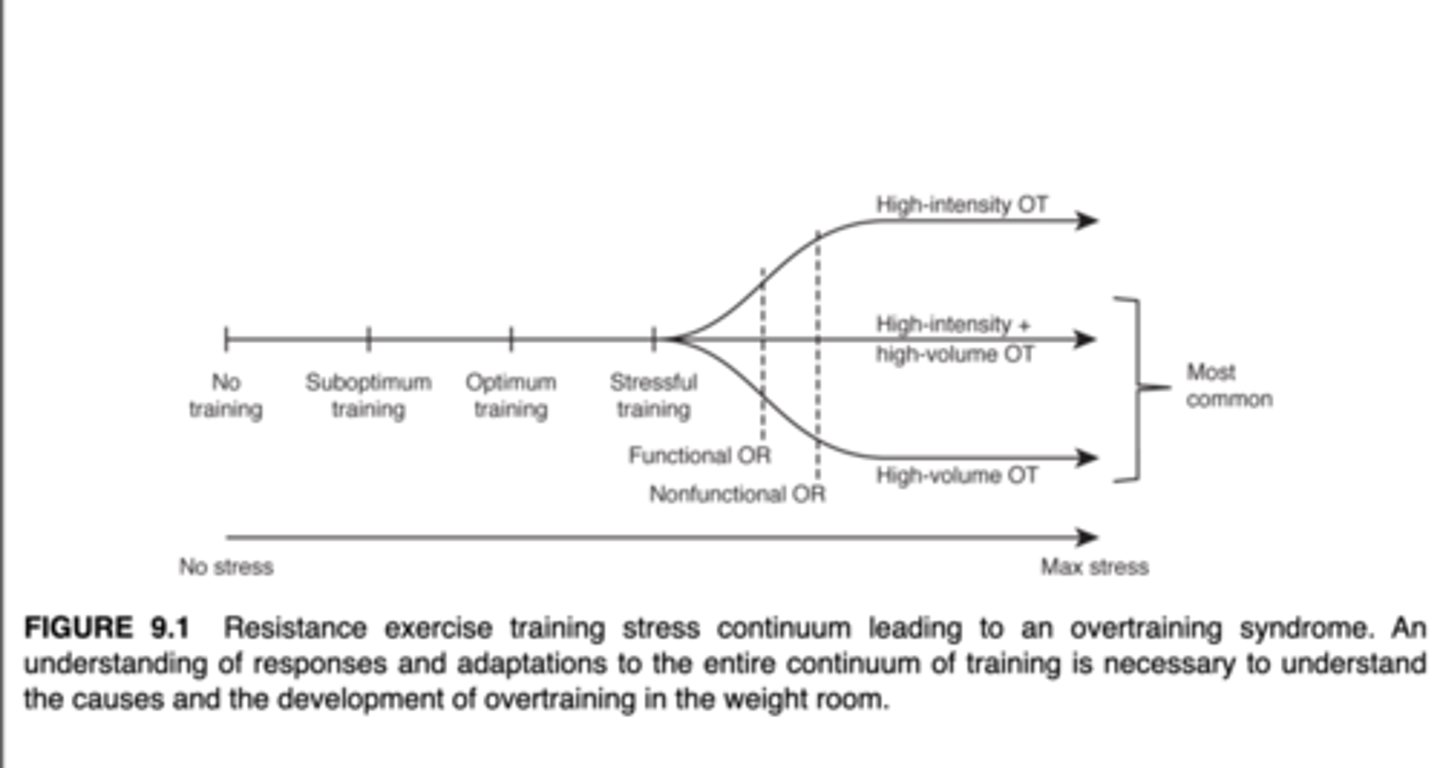
The most common form of overtraining is???
high intensity + high volume
or high volume
How does the Rt stress continuum progress?
no training
suboptimum
optimum
stressful
functional OR
nonfunctional OR
THEN,
either high intensity OR, High inten. + high volume, high volume
Figure 9.2 - General Adaptations Syndrome in Response to Stress
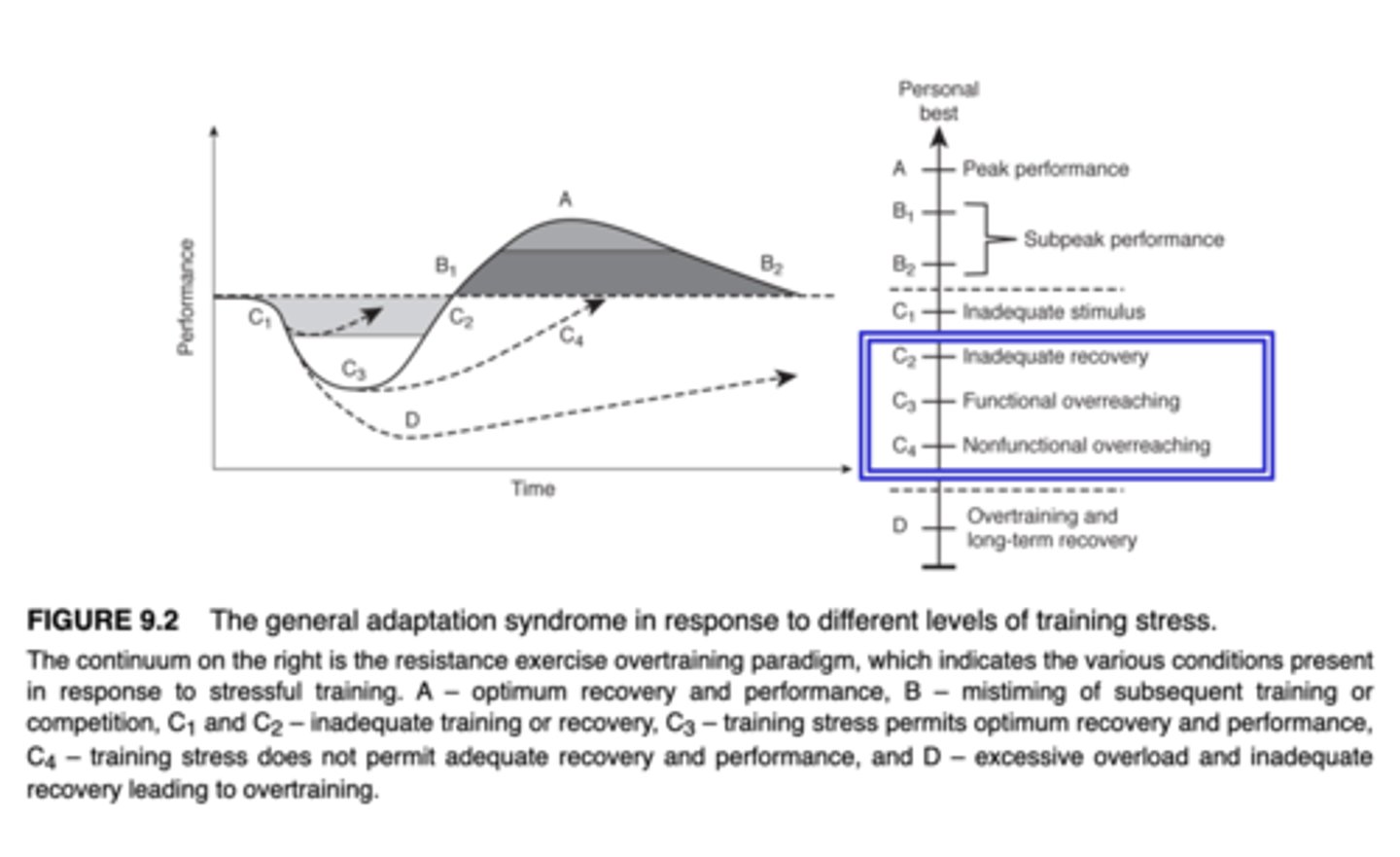
General Adaptation Syndrome - A-B2
A - peak performance
B1, B2 - subpeak performance
General Adaptation Syndrome - C1
inadequate stimulus
GAS - C2, C3, C4
C2 - inadequate recovery
C3 - Functional overreaching
C4 - non-functional overreaching
GAS - D
Overtraining and long-term recovery
Figure 9.11 - Progression of OT in RT
normal RT
psychological disturbances
neural recruitment alterations
speed impairment
RFD impairment
Power impairment
1RM strength impairment
reduced training capacity
OTS
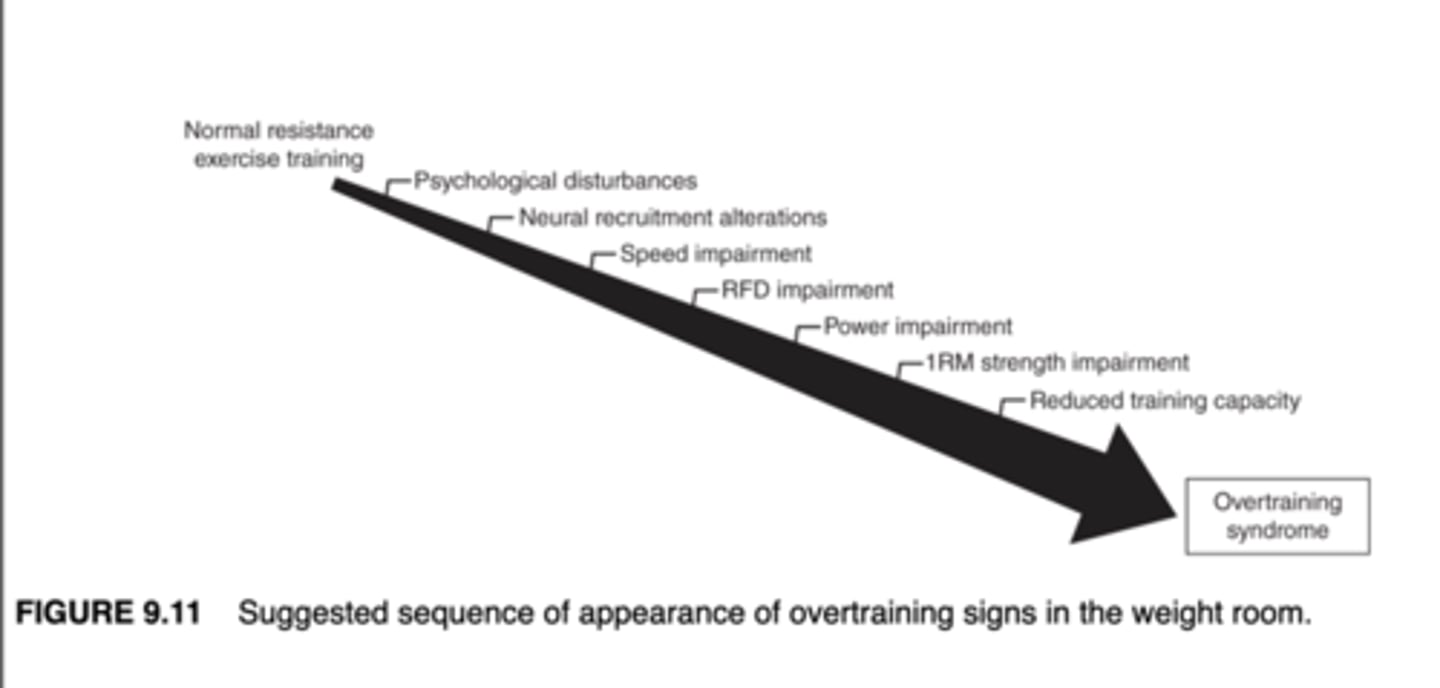
General Training Principles
Specificity, overload, variation, progression
specificity
Training adaptations will be specific to the training performed
specific to:
- muscle groups (legs v. arms)
- range of motion (quarter/half squats)
- energy system (ATP-PC, lactate etc.)
- velocities
-movement patterns (sport specific movements in overloaded)
- contraction types
Overload
A training stress or intensity that is greater than the client is used to.
Progressive overload
The process of altering training stress as a client adapts.
- Overload in what? weight lifted, reps performed in a set, sets performed, shorter rest period, # training of sessions
Keys of Progressive Load
-Should be goal focused
-should be systematic (don't progress multiple at a time)
-appropriate for client
Variation
The manipulation of specific training variables such as volume, intensity, exercise selection, frequency of training, rest interval and speed of movement.
Why vary training?
1. Optimizes adaptation,
- Increase the novelty of the stimulus
2. Prevents injury
- Reduced stress on one tissue
3. Allows peaking
More variation means what?
Less likely to see stagnation of adaptation
Less likely to see overuse injuries
Periodization
A logical phasic manipulation of training factors to optimize specific training outcomes at specific time points.
What are the 9 program design variables?
1. Needs Analysis
2. Training frequency
3. Exercise selection
4. Exercise order
5. Training load and repetitions
6. Volume
7. Rest periods
8. Training variation
9. Progression
SMART goals
Specific, Measurable, Attainable, Realistic, Timely
·What are the two steps of a needs analysis non-athlete/client?
1. The client's goals
2. The client's current physical condition
What are the two steps of a needs analysis athlete?
1. The demands of the sport
2. The relative strengths & weakness of the athlete
Comparing them to their peers and other athletes in similar condition
To understand an individual's current fitness levels the following are important to know what?
Passive and active measurements
Passive measurements
Resting heart rate, blood pressure, body composition, height, weight, girths,
Active measurements
Muscular strength, muscular endurance, cardiovascular endurance, and flexibility
What are three considerations that should be made for athletes when evaluating their sport?
Movement Analysis
-Body and limb movement patterns and muscular involvement
Physiological analysis
-Strength, power, hypertrophy, and muscular endurance priorities
Injury analysis
-Common sites for joint and muscle injury and causative factors.
What are core exercises?
recruit one or more large muscle areas,
involve two or more primary joints,
receive priority when one is selecting exercises because of the demands on the body and relevance to training goals
Ex: Bench press (chest, shoulder, triceps + lots of weight + large weight + caloric expenditure)
What are assistance exercises?
usually recruit smaller muscle areas,
involve only one primary joint,
are considered less important towards overall training goals
Ex: chest -flys
What are power exercises?
Power = Force x Velocity
MUST have velocity
Power can be attained by lifting heavy to moderate loads at fast velocities
What are some examples???
Clean + jerks, FILL IN MORE, power clean, snatches, loaded jumps, bench press throw
What order should exercises be prescribed in?
Power, core, assistance
What is the principle of specificity and how can we use it for exercise selection?
Principle of Specificity - The more similar the training activity is to an actual task, the greater the likelihood that there will be a positive transfer to that task.
The PoS guides exercise selection by aligning exercises with goals, selecting muscle groups that you want to develop for your goal, energy system, skill develop, etc
By targeting your training to specific outcomes, the principle of specificity helps you maximize results and avoid unnecessary training that doesn't move you closer to your goals.
· What is training frequency?
Training frequency is the number of training sessions completed in a given time period.
For a resistance training program, a common time period is one week.
(micro cycle)
How does training status influence optimal training frequency (know table)?
Training status affects the number of rest days needed between sessions.
Three workouts per week are recommended for many athletes to allow sufficient recovery between sessions.
· How does sport season influence training frequency?
Training frequency is often adjusted according to the demands of a sports season, with variations across the off-season, pre-season, in-season, and post-season. Here's how each season typically influences training frequency:
By adjusting training frequency based on the season, athletes can maintain performance levels while avoiding burnout and injury, ensuring they peak at the right times.
4o
Be able to explain who should and should not use a split routine.
Split Routine - More highly resistance-trained (intermediate or advanced) athletes can augment their training by using a split routine in which different muscle groups are trained on different days.
We don't want untrained individuals to have split routines → ex: entire days related to legs = too much damage
What is split training?
different muscle groups are trained on different days
What are common 3, 4, and 5-day splits?
3- full body
4 - lower, upper, rest, lower, upper
5 - chest, shoulder, triceps + lower body + back, traps, bis
6 - chest + back, lower body, Shoulders + arms, rest wednesday
When (and for whom) is a split training program NOT appropriate?
We don't want untrained individuals to have split routines → ex: entire days related to legs = too much damage\
Not in season -- too much stress!
Not for 1 day or 2 days per week (too much in between)
The general guideline is to schedule train-ing sessions so that there is at least __________ rest or recovery day—but not more than _______—between sessions that stress the same muscle groups.
one, three
Overtraining
An excessive frequency, volume, or intensity of training that results in extreme fatigue, illness, or injury
Can be just a frequency and intensity, or just one
Functional overreaching
Reflects the normal "shock / alarm" phase that is part of GAS.
This is detrimental to acute performance but is beneficial to long-term adaptation
Non-functional overreaching
Prolonged "shock / alarm" phase that suppresses the adaptation (or supercompensation) portion of the GAS
This is detrimental to both acute performance and long-term adaptation
Not a healthy workout
What factors can lead to overtraining?
- Training stress cumulatively builds and is exacerbated by insufficient rest / recovery, and/or nutrient intake.
- High intensity overtraining - too intense in short period of time → not recovery
Not common in RT
- High Volume overtraining - overall training too much; stressing too much
Symptoms of Overtraining
Psychological effects:
Decreased desire to train, decreased joy from training
Physiological
Sympathetic to Parasympathetic ratio
Hormonal: T to C ratio
Too rhythmic HRV = OTS (military application)
Performance
Speed, Power then Stretch
Order of Systems Impairment during OTS
Psychological disturbances
Neural recruitment alterations
Speed impairment
Rfd impairment
Power impacirment
1RM strength impairment
Reduced training capacity
OTS
· Be able to set up a system by which over-training can be identified using appropriate tests.
Note: Each person is different, this is just an example
Strength testing baseline - isometric midthigh pull, grip strength at beginning of workout as daily marker
General questionnaires
GPS
Power measurements - quick jump assessments (drop jump before training) → 3 x and shows people at risk of overtraining = people who would then get sick; early interventions
* test multiple times in semester
Be able to explain how to correct (and prevent) over training and ID those at risk.
REST
VARIATION
Note: training with more max loads or volumes will require more rest; & seasonal demands may limit time avail. for RT

How does load influence repetitions possible? (know table)
The greater the load, the lesser the amount of reps
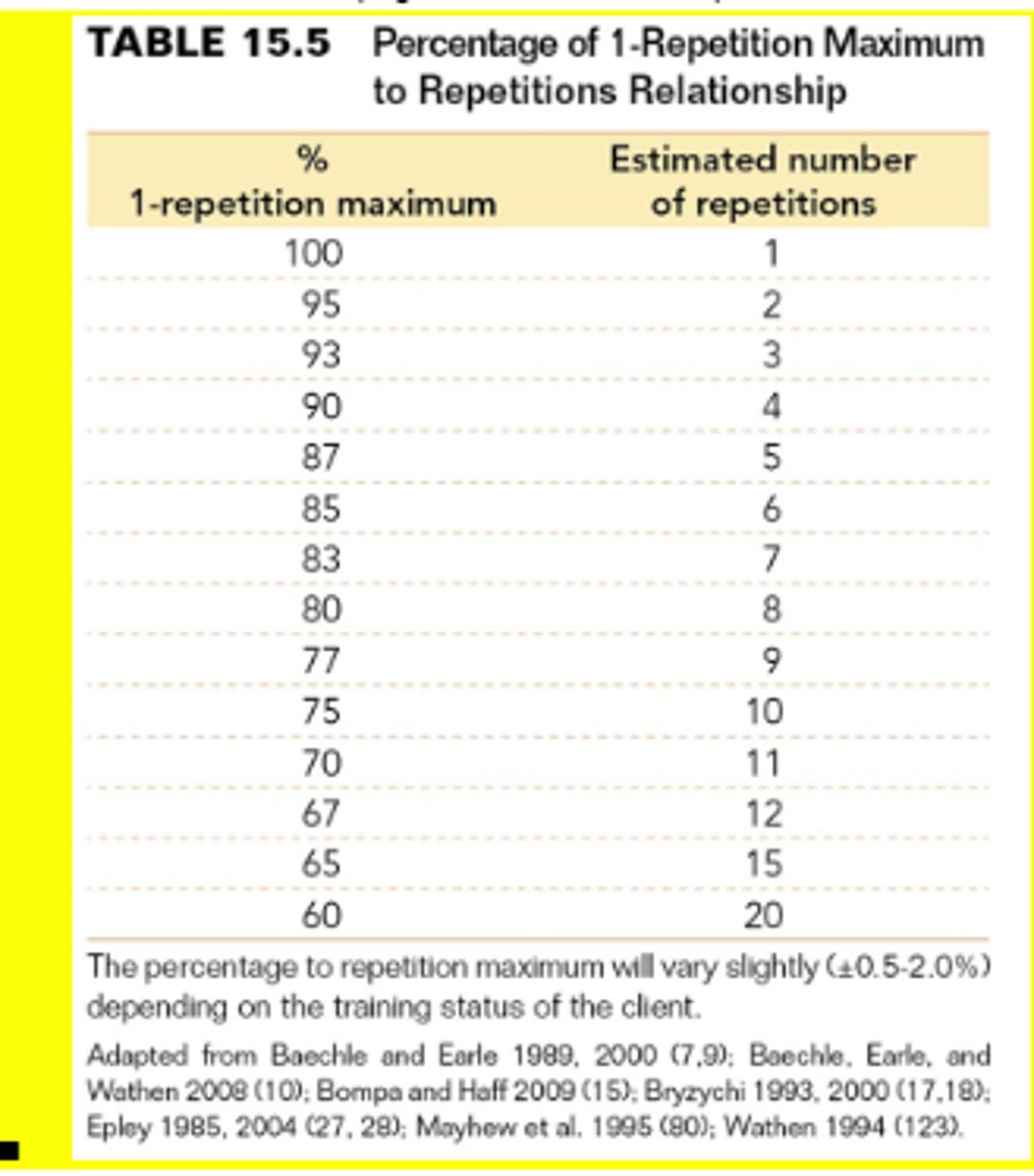
100 RM
1 rep
95 %RM
2 reps
93 %RM
3
90% RM
4 reps
87% RM
5 reps
85 %RM
6 reps
83%RM
7 reps
80% 1RM
8 reps
77% 1RM
9 reps
75%1 RM
10 reps
70% 1RM
11 reps
67% 1RM
12 reps
65% 1RM
15 reps
60% 1RM
20 reps
What are: 1RM, 10RM and RM and how do they differ?
1Rm - 1-rep-maximum; Greatest amount of weight that can be lifted with proper technique for only one repetition.
10RM - max load able to complete 10 reps (75% 1RM, used to estimate)
RM - Most weight lifted for a specified number of repetitions.
Limitations of %1RM or %RM?
1. The load-rep relationship isn't perfect
2. Training status affects the load-relationship
--The stronger you are the less reps can often be completed with a given load
--Untrained person may not apply; don't have enough type 2 muscle fibers
Powerlifter - huge 1-rm; give 65 since their fatigue is more
3. Fatigue can reduce the reps that can be performed in later sets
4. Generally, is only used for core exercises
It doesn't work for exercises such as dumbbell side raises
5. More reps can often be performed on machines compared to free weights
6. It is not safe to max strength test untrained clients
7. It's not time efficient to test every possible exercise
8. Some muscles don't respond well to 1-RM
Ex: core exercises - type 1 muscle fibers high
How does training load & repetitions influence adaptations?
Strength: Use relatively heavy loads
Power: Use relative heavy loads OR high velocity movements
Hypertrophy: Use moderate loads.
Muscular Endurance: Use light loads
10 reps is ideal overlaps a lot!!
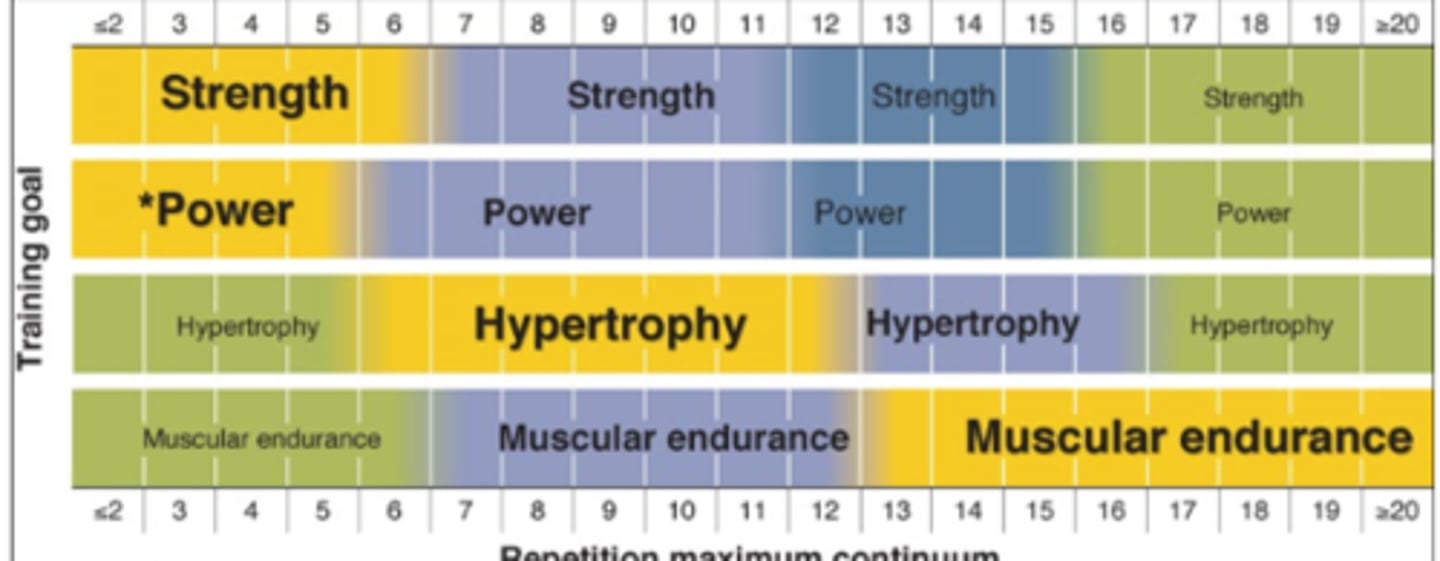
Loads & reps must be assigned together
Why?
They are codependent
Inverse relationship
More reps, less load we can have
In power training you do not train with maximal loads (i.e. RM), why is this?
Need to be able to maintain velocity since power = force x velocity
In short, avoiding maximal loads in power training enables athletes to maximize speed and explosive force, while minimizing injury risk and maintaining the specificity needed for athletic performance.
Who should not take part in power training and why?
beginners - lack strength and coordination for complex movements; not applicable for goals usually; injury risk
Older adults
musculoskeletal issues
Should we lift maximally every day?
NO
“Heavy / Hard Days”
Loads are designed to utilize full RM
The greatest resistance that can be successfully lifted for the goal number of repetitions.
Other training days
Loads are reduced (intentionally) to provide recovery after the heavy day while still maintaining sufficient training frequency and volume.
What is the "2-for-2 rule" and how can you use it?
If they can perform two or more repetitions over his or her assigned repetition goal in the last set in two consecutive workouts for a given exercise, weight should be added to that exercise for the next training session.
(Conservative method)
* AS you get farther away from testing = more changes
Ex: assigned 3 sets of 8 at 80% 1-RM but can do 10 for two consecutive workouts, extra weight can be added
What is volume?
Total amount of work performed in a workout or training session. It's typically represented by the total number of sets, reps, and load completed for each exercise.
What is repetition volume?
total number of repetitions performed during a workout session.
How many efforts did you put in today?
What is load volume?
The total number of sets multiplied by the number of repetitions per set then multiplied by the weight lifted per rep (can use absolute or relative weight) {percent 1-RM}
Total reps x load
how we track volume over time!
Will you adapt more from single set or multi-set training?
Multiple sets - usually prescribing 3 as minimum, where adaptations start to plateau
After 4 = some decay
Why use a single set?
Untrained individuals
Many studies indicate that higher volumes are necessary to promote further gains in strength,
Want to avoid non-functional overreaching
Other?
Cross-fit
Circuits
Warm-up exercises